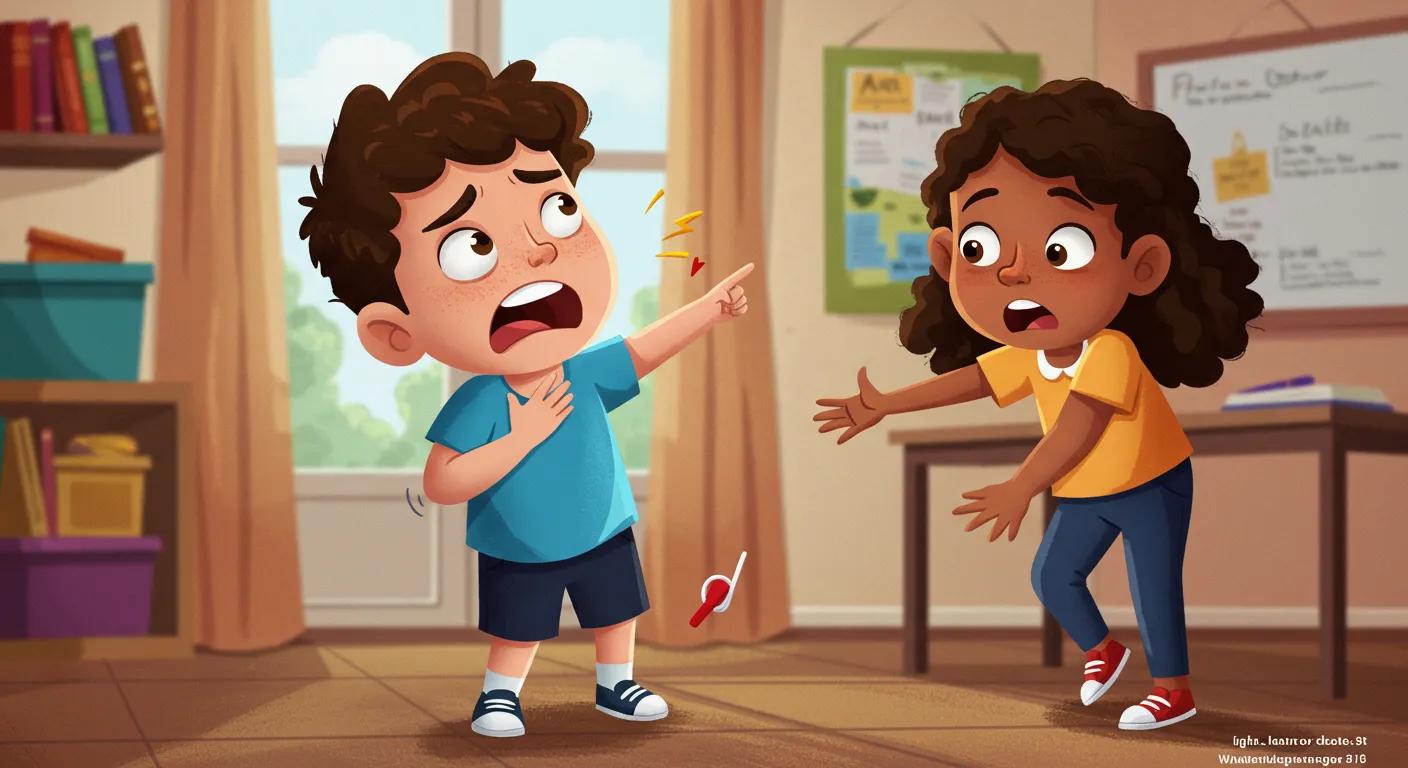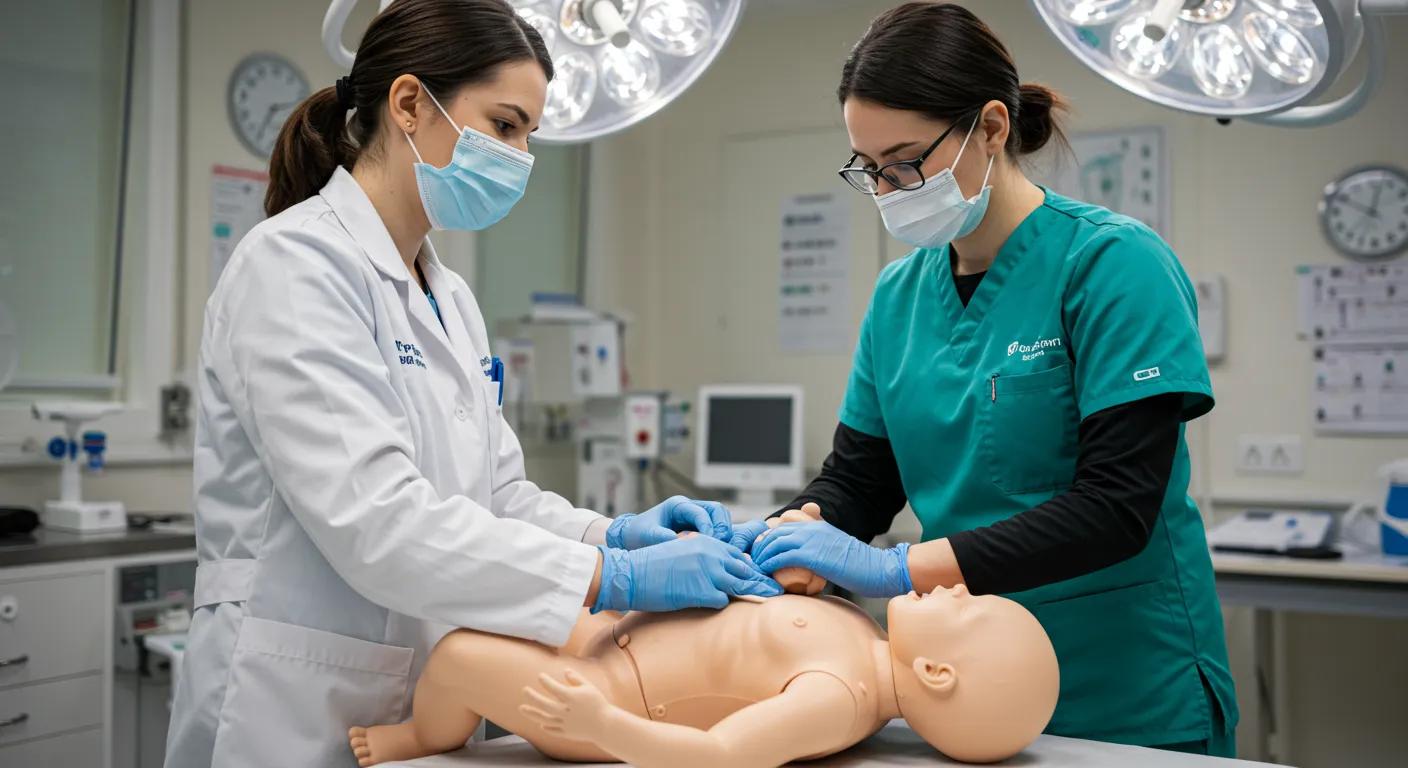


Comprehensive Guide to Choking First Aid, Child Safety, and Emergency Response Training

Comprehensive Guide to Choking First Aid, Child Safety, and Emergency Response Training
This guide addresses choking first aid, child safety, and emergency response training. It outlines the signs of choking in infants and children, explains how to perform first aid correctly, and provides best practices to prevent choking hazards at home and elsewhere. The guide also describes emergency training including CPR and AED certification, and helps parents, caregivers, and childcare center owners locate certified training programs. With rising concerns from mealtime hazards to playground emergencies, this resource offers scientifically based instructions, practical examples, and actionable tips to ensure caregivers are fully prepared for life‐saving interventions. It integrates current research, expert recommendations, and a detailed breakdown of techniques such as the Heimlich maneuver to serve as a complete resource for those responsible for child safety.
Transitioning from understanding the signs to practical interventions, the following sections provide step-by-step instructions and key prevention measures.
What Are the Signs and Symptoms of Choking in Children and Infants?
Recognizing choking signs in children and infants can save lives. Early indicators include sudden difficulty breathing, a weak or ineffective cough, and high-pitched or abnormal inhalation sounds. The child’s behavior may shift quickly; they may appear panicked, unable to speak, or show changes in skin color. Early detection is critical to prevent hypoxia and potential brain damage.
How to Identify Choking Signs in Infants
Infants may display subtle signs when choking. Their cough may become feeble, and breathing can shift to high-pitched noises as air struggles to pass an obstructed airway. A change in skin color—turning pale or bluish—may occur, and an infant might become unusually quiet or stop crying. Caregivers should closely monitor infants during feeding or play. For example, if an infant shows disrupted coordination between sucking and breathing, immediate action is needed to check for an obstruction.
What Are Common Choking Symptoms in Toddlers and Older Children?
Toddlers and older children usually exhibit more obvious symptoms. They may be unable to speak or cry loudly, and a weak, persistent cough may be evident. Other signs include clutching the throat, drooling, difficulty swallowing, and wheezing. Children might also display distress or agitation by leaning forward or using hand gestures to point to discomfort in the neck or chest. Vigilance is particularly important during mealtimes or when children play with small objects.
When to Call Emergency Services for a Choking Child
Emergency services must be contacted immediately if a child’s condition does not improve within seconds of initiating first aid or if the child becomes unresponsive. If the child cannot breathe or there is a complete silence without coughing, call 911 (or the local emergency number) immediately. Also, if cyanosis (bluish skin) is observed or if the child loses consciousness, professional help is essential—even after the obstruction appears to be cleared—to rule out any complications.
How Do You Perform Choking First Aid for Infants and Children?

Proper choking first aid can prevent airway obstruction from becoming fatal. First aid techniques vary between infants and older children because of their different anatomical structures. The two primary methods are the Heimlich maneuver for older children and back blows with chest thrusts for infants.
What Are the Step-by-Step Instructions for the Heimlich Maneuver on Children?
For children, the Heimlich maneuver uses controlled abdominal thrusts to expel an obstruction. Stand or kneel behind the child, wrap your arms around their waist, make a fist, and place it just above the child’s navel. Grasp the fist with your other hand and deliver five sharp inward and upward thrusts. If the object does not dislodge, check the child’s mouth carefully and remove any visible obstruction if possible. Repeat the process with caution while monitoring the child’s breathing. Proper training is essential because accurate, timely thrusts have been shown to clear obstructions in most cases.
How to Perform Back Blows and Chest Thrusts for Infants
For infants under one year, back blows and chest thrusts are recommended. Hold the infant face down on your forearm with the head supported and lower than the body. Give five firm back blows between the shoulder blades using the heel of your hand. If the obstruction persists, turn the infant over while supporting the head and perform five chest thrusts by pressing on the middle of the chest with two fingers. Alternate between five back blows and five chest thrusts until the obstruction is cleared or the infant becomes unresponsive.
What Are the Differences Between First Aid for Infants and Older Children?
The key differences lie in technique and force applied. Infants have delicate rib cages and smaller airways, requiring gentle yet firm back blows and chest thrusts. In contrast, older children can tolerate the stronger abdominal thrusts used in the Heimlich maneuver. The position during the intervention also differs: infants are often held face down, while older children are treated in an upright position. In all cases, caregivers are advised to obtain formal training to minimize the risk of injury and to ensure effective first aid.
When Should You Stop First Aid and Seek Medical Help?
Continue first aid until the object is expelled, the child resumes normal breathing, or the child becomes unresponsive. If the child stops breathing or loses consciousness, call emergency services immediately and start CPR if you are trained. Even after a visible removal of the obstruction, a follow-up medical examination is essential to check for residual swelling or injury. It is important to stop active first aid once professional help arrives to prevent further harm.
What Are the Best Practices for Preventing Choking and Ensuring Child Safety?
Preventing choking and ensuring child safety require both immediate and long-term measures. Daily routines at home and in childcare settings should include practices that reduce risk, coupled with continuous education on the early signs of choking.
What Are Common Choking Hazards in the Home and How to Avoid Them?
Common choking hazards at home include small objects, food items that are difficult to chew, and toys with detachable parts. To minimize these risks, choose age-appropriate toys without small components and modify food items such as grapes, hot dogs, or nuts by cutting them into smaller pieces. Maintaining organized, clutter-free play areas and using child-proof storage can further reduce risks.
How Can Parents and Caregivers Prevent Choking During Mealtime?
Supervision during meals is crucial. Ensure that children are seated and focused on eating rather than distracted by play or screens. Modify high-risk foods by cutting vegetables and fruits into small, manageable pieces. Encourage slow eating and thorough chewing, and consider holding brief "safety checks" during mealtime to inspect food portions and settings.
What Are Essential Child Safety Tips for Different Environments?
Child safety extends beyond the home. In daycare centers, playgrounds, and social gatherings, keep hazardous materials and small objects out of reach and design play areas with safety in mind. Outdoor spaces should have soft ground materials and designated play zones. Regular safety drills and clear emergency response protocols in childcare facilities help ensure rapid and coordinated action when needed.
How to Create a Safe Play and Sleep Environment for Children
A safe environment requires careful planning. For play areas, use padded surfaces, rounded furniture edges, and secure small items. For sleep environments, select cribs and bedding that meet safety standards, and keep loose items such as pillows away from infants. Regular safety audits, proper supervision, and maintenance of equipment like smoke detectors and first aid kits further enhance safety in both play and sleep areas.
Below is a list of five common choking hazards along with prevention tips:
Small Toys – Choose age-appropriate toys without detachable parts.
Round Foods – Cut foods such as grapes or hot dogs into small pieces.
Loose Coins – Store small items like coins in locked drawers.
Batteries – Keep batteries and similar items in child-proof containers.
Jewelry and Beads – Remove or securely store small decorative items.
What Does Emergency Response Training for Child Safety Include?
Emergency response training equips caregivers with essential skills for handling various crises. Such training includes CPR and AED certification for pediatric emergencies, first aid for choking, and strategies for allergic reactions and trauma cases. The curriculum builds confidence, enabling caregivers to perform life-saving procedures under pressure.
What Is Covered in CPR and AED Certification for Pediatric Emergencies?
Pediatric CPR and AED courses focus on the differences between adult and pediatric resuscitation. Training covers correct hand placement, appropriate compression depth, and the ratios of compressions to rescue breaths. Participants learn to assess emergencies quickly, call for help, and use automated external defibrillators following pediatric guidelines. Hands-on practice with manikins reinforces these essential skills.
How Does First Aid Training Prepare Caregivers for Allergic Reactions and Other Emergencies?
First aid training extends beyond choking and cardiac arrest. It covers early signs of anaphylaxis, proper epinephrine auto-injector use, wound and burn management, and poisoning responses. The training includes scenario-based exercises that help caregivers remain calm and effective under stress. This comprehensive approach reduces the risk of severe outcomes.
What Are the Benefits of Online, In-Person, and Blended Learning Options?
Emergency response courses are available in various formats: - Online Courses: Provide interactive modules and video demonstrations, offering convenience and self-paced learning. - In-Person Training: Emphasizes hands-on practice with immediate instructor feedback. - Blended Learning: Combines online theory with practical sessions to enhance both conceptual understanding and hands-on skills.
How to Choose the Right Emergency Response Course for Parents and Caregivers
When selecting a course, consider factors such as accessibility, accreditation, and certification duration. Parents and daycare owners should look for state-approved courses with reliable renewal policies. Reading reviews and comparing course content and instructor expertise can help ensure you choose a program that effectively enhances child safety.
Below is a table comparing emergency response training options:

Where Can You Find Certified Choking First Aid and Emergency Response Training Near You?
Locating certified choking first aid and emergency response training is straightforward. Accredited training providers are commonly found in urban and community centers. Many daycare centers partner with local emergency services or organizations such as the American Red Cross to provide training sessions.
How to Locate Accredited CPR and First Aid Training Providers Locally
Search online directories using terms like "emergency medical responder course near me" or "cert training near me." Organizations like the American Red Cross and American Heart Association have comprehensive lists of certified training centers. Many providers also offer search filters by location, course type, and certification period.
What Are the Certification Requirements and Validity Periods?
Certification generally requires both theoretical knowledge and hands-on skill demonstrations in techniques such as CPR, the Heimlich maneuver, and AED use. Most certifications last for two years, after which refresher courses are recommended. Some programs offer accelerated renewals for previously certified individuals.
How to Prepare for and Pass Pediatric Emergency Response Certification
Preparation involves a thorough review of course materials, hands-on practice with mannequins, and participation in simulation exercises. Attending practice sessions and engaging with additional resources, such as instructional videos and guidelines, can boost confidence and increase the chances of successful certification.
What Are the Most Frequently Asked Questions About Choking First Aid and Child Safety?
Addressing frequently asked questions helps clarify common concerns for caregivers during emergencies.
How Long Does It Take to Learn CPR and Choking First Aid?
Basic CPR and choking first aid can be learned in a single 2-4 hour session. However, mastery may require ongoing practice and periodic refresher courses, as skills can decline within six months without practice.
Can You Perform the Heimlich Maneuver on a Conscious Infant?
No. The Heimlich maneuver is not recommended for infants. Instead, infants should be treated with back blows and chest thrusts, performed gently due to their delicate anatomy.
What Should You Do if a Child Becomes Unresponsive During Choking?
If a child becomes unresponsive, immediately call emergency services and begin pediatric CPR. Check the child’s mouth for any visible blockage and continue CPR until help arrives, even if the airway appears clear afterward.
How Can Childcare Providers Develop Effective Emergency Action Plans?
Childcare providers should create comprehensive emergency plans that detail procedures for choking and other emergencies. Regular reviews and drills—with designated roles for staff—build confidence and ensure swift, coordinated responses when needed.
What Are the Warning Signs That Indicate a Need for Immediate Medical Attention?
Warning signs include complete inability to breathe, sudden changes in skin color, or the absence of coughing or gagging. If a child’s consciousness declines or they exhibit continuous distress, immediate medical attention is required.
How Can You Use Visual and Interactive Tools to Improve Emergency Response Skills?
Visual and interactive tools enhance learning and retention of emergency response techniques. Videos, diagrams, infographics, interactive quizzes, and checklists simplify complex procedures and provide clear, step-by-step guidance.
What Are the Best Videos Demonstrating Choking First Aid Techniques?
Several reputable organizations, including the American Red Cross, produce videos demonstrating choking first aid. These videos often include slow-motion segments that highlight the proper hand placement and force required for techniques like the Heimlich maneuver and back blows.
How Do Infographics and Diagrams Help in Learning the Heimlich Maneuver?
Infographics break down the Heimlich maneuver into simple steps, showing exact hand positioning, movement, and necessary repetitions. They serve as quick-reference guides during emergencies and help differentiate between techniques used for children and adults.
What Interactive Quizzes and Checklists Enhance Child Safety Awareness?
Interactive quizzes test caregivers on emergency procedures, reinforcing key concepts, while checklists provide step-by-step instructions during choking emergencies. These tools ensure that critical information is retained and applied effectively during real-world situations.
Below is a summary table of advanced emergency response tools:

Frequently Asked Questions
Q: What are the initial signs that a child is choking? A: Look for a weak cough, difficulty breathing, and changes in skin color (pale or blue). These signs are most noticeable during mealtime or play.
Q: How effective is the Heimlich maneuver in older children? A: When performed promptly and correctly, the Heimlich maneuver is highly effective, clearing the airway in a majority of severe choking incidents.
Q: Can regular training in emergency response truly save a child’s life? A: Yes. Regular training in CPR and choking first aid equips caregivers with the necessary skills to act swiftly and effectively, greatly improving outcomes during emergencies.
Q: How often should caregivers renew their first aid and CPR certifications? A: Certifications are typically valid for two years, but annual refresher courses are recommended to keep skills up-to-date.
Q: Are there specific courses available that focus solely on pediatric emergency response? A: Yes. Many providers offer pediatric emergency response courses that tailor techniques specifically for the anatomical and physiological needs of young children and infants.
Q: What should I do if a child remains unresponsive after first aid measures? A: Immediately call emergency services and begin pediatric CPR. Continue resuscitation until professional help takes over.
Q: Can interactive tools improve the effectiveness of emergency training for childcare providers? A: Absolutely. Videos, quizzes, and simulation drills not only reinforce correct procedures but also help retain emergency response skills.
Final Thoughts
This guide provides a concise yet comprehensive overview of choking first aid, child safety practices, and emergency response training. By recognizing early warning signs, performing appropriate first aid, and following established safety protocols, caregivers can prevent severe outcomes and ensure the well-being of children. Regular training, whether through online, in-person, or blended courses, along with the use of visual and interactive aids, enhances preparedness and response during emergencies. Investing in these specialized training programs is vital in creating safer environments for children.

Infant Care
Nurturing and caring environment for your little one's growth.

Toddler Care
Nurturing growth and discovery in a safe, loving environment.

Preschool
Nurturing creativity and growth in a safe, engaging environment.
Ga Pre-K Lottery
Unlock educational opportunities with our Ga Pre-K Lottery program.
AfterSchool
Enriching and safe after-school care tailored to children's growth.
Kindergarden
Nurture young minds with personalized attention and engaging activities.
Testimonials
Our Parents love us
Here's some of what they had to say
My daughter has been going here for a year. She and we love it! The staff is very kind and helpful. They listen to my concerns and always help her and engage her with activities that fit her abilities instead of just her age! We have restricted diet; they work with us to accommodate her. Chroma has become our second family!
Khawla M.

My daughter loves it here. She loves all her teachers, she learns something new every day. We love the activities they provide our child with.
Jessica B.
